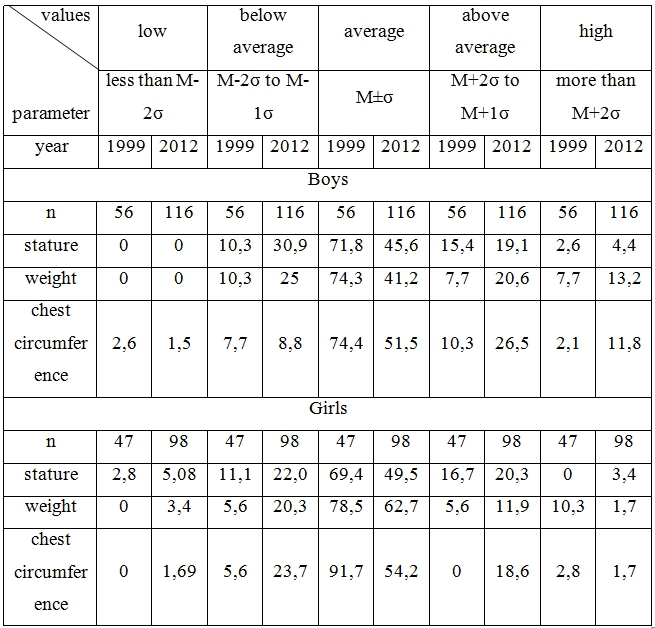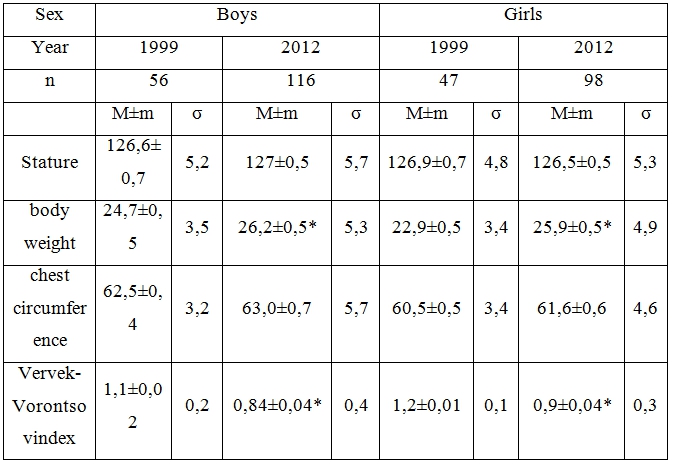СРАВНИТЕЛЬНАЯ ОЦЕНКА ФИЗИЧЕСКОГО РАЗВИТИЯ ДЕТЕЙ В УСЛОВИЯХ ЗАПАДНОЙ СИБИРИ ЗА 12 - ЛЕТНИЙ ПЕРИОД
Гребнева Н.Н.1, Смирнова М.В.2
1 Доктор биологических наук, профессор, 2 старший преподаватель, ФГБОУ ВО «Тюменский государственный университет» Кафедра дефектологии и возрастной физиологии
Работа выполнена за счет средств автора в рамках инициативной НИР
СРАВНИТЕЛЬНАЯ ОЦЕНКА ФИЗИЧЕСКОГО РАЗВИТИЯ ДЕТЕЙ В УСЛОВИЯХ ЗАПАДНОЙ СИБИРИ ЗА 12 - ЛЕТНИЙ ПЕРИОД
Аннотация
В статье представлены результаты сравнительной оценки физического развития детей 7-8 лет за 12-летний период времени (1999-2012). Выявлено резкое снижение числа детей со средним (нормальным) уровнем физического развития и его дисгармоничность, обусловленная, преимущественно, избытком массы тела. Повышение массы тела зависит от половой принадлежности: показатели девочек в 2 раза превышают таковые у мальчиков. Предполагается, что на снижение физического развития современных детей 7-8 лет оказывают влияние неполноценность и нерациональность питания, снижение двигательной активности, в том числе в связи с началом систематического школьного обучения.
Ключевые слова: дети, физическое развитие, двигательная активность.
Grebneva N.N.1, Smirnova M.V.2
1 PhD in Biology, Professor, 2 senior teacher, Tyumen State University
EVALUATION OF PHYSICAL DEVELOPMENT DYNAMICS IN MODERN CHILDREN 7-8 YEARS OF AGE
Abstract
The article contains the results of comparative evaluation of children’s physical development level (7-8 years old) over a twelve-year period (1999-2012). The study revealed drastic decrease in the number of children with average (normal) level of physical development and its disharmony, which is mainly caused by excessive body weight.Increase in body weight depends on the sex: the indicatorsamong girls are twice as high as same indicators for boys. It is assumed that decrease in physical development level of modern children 7-8 years of age is caused by nutritional inferiority, irrational nutrition and decline in physical activity,particularly due to the start formal schooling.
Keywords: children, physical development, physical activity.
Harmonious physical development is the most important criteria in children’s health status assessment. It reflects preservation of genetically determined ways of development and its deviation in either direction. Regular tracking of physical development trends is vitally important for prenosological diagnostics. Comparison of findings for people of the same age but from different generations reveals uneven pace of development: either its acceleration or its deceleration (retardation). Over the last 100 years, until the early 1990s, different domestic [3-6; 8; 9] and foreign scientists [10, 11] were widely noting acceleration of physical development of children and adolescents. In foreign literature the terms “secular trend” and “epochal change” are widely used; they are characterized by a complex combination of interrelated phenomena. It is not only acceleration in children’s and adolescents’ development and maturation, but also changes in development of adults (body weight increase, prolongation of reproductive period, preservation of working capacity in older age, prolongation of life etc.). At the same time, the majority of authors associate acceleration with increase of basic anthropometric dimensions – height and weight, chest circumference, i.e. basic physical development parameters.
The aim of this study is comparative assessment of physical development level (basic body dimensions) in children 7-8 years of ageover a twelve-year period, in living conditions of the middle part of West Siberia. In order to achieve the objective the following tasks were set:
- define main parameters of physical development of modern children 7-8 years of age(based on the data of Tyumen city);
- conduct comparative analysis of the collected data with the findings from 12 years ago for Tyumen children of the same age;
- evaluate the level of physical development of modern children 7-8 years of age.
The studywas carried outbased on the data obtained from two secondary general schools, which have identical curriculums and are located no more than 200 meters apart. Two hundred and fourteen children were examined, 116 boys and 98 girls. Examination was conducted in spring. All measurements were taken in morning time, in quiet environment, after an intensive training. The anthropometric measurements of basic body dimensions were taken for the purpose of evaluation of physical development level: height, weight, chest circumference.
Anthropometric measurements were made with an anthropometer,in accordance with the guidelines from the Research Institute of Anthropology of Moscow State University and recommendations of V.V. Bunak and V.G. Vlastovskiy [1; 2; 7]. Chest circumference was measuredat inhalation and exhalation, with subsequent measurement of lungs excursion and anthropometric indices. The following indices were calculated: the weight-for-height, or the Rohrer Index, the Pignet Index and the Vervek-Vorontsov Index. The Rohrer Index is used as a group weight-for-height index of dolichomorphism and brachymorphism; the Pignet Index allows defining a somatotype, and the Vervek-Vorontsov index indicates the pace of growing.
Individual evaluation of each child physical development level was conducted using the standard deviations method (σ), according to the following scale:
- Average level: the indicators deviate within the limits of М-1σ to М+1σ;
- Above average: within the limits of М+1,1σ to М+2σ;
- High: within the limits of М+2,1σ and higher;
- Below average: within the limits of М-1,1σ to М-2σ;
- Low: within the limits of М-2,1σ and more.
Morphological and functional parameters of children’s bodies weremeasured on a three-point scale [11; 12]. Distribution of the main anthropometric parametersby sigma range is presented in Table 1
Table 1 - Distribution of the main anthropometric parameters in children 7-8 years of age by sigma range, %
Note: year 1999 –data by Zagaynova A.B.; year 2012 – own data.
A statecharacterized by weight and chest circumference corresponding withstature of a child or deviating within 1 or more sigma of regression (due to muscular development) is considered harmonious. Disharmonious state is described by weightand stature values beingless than reference values by 1,1-2σ;orexceedingthereference valuesby 1,1-2σ due to excessive fat deposition. Astate considered rather disharmonious is the one described by weight and chest circumference values being less than reference values by 2,1σ and more; or when these values exceed the reference values by 2,1σ. Three groups of physical development were defined based on this evaluation:
- Normal physical development group – average, increased or reduced stature and harmonious correspondence of stature and weight.
- Physical development risk group – short and tall stature and harmonious development; or disharmonious development caused by either body mass deficit or excess.
- Group with physical development deviations –either very short or very tall stature at any body weight; rather disharmonious growth caused by body weight excessat any stature;rather disharmonious growth caused by body weight deficitat any stature.
Distribution of children by physical development groupsis presented in Table 2.
Table 2 - Distribution of children 7-8 years of age by physical development groups, %
Note: year 1999 – data by Zagaynova A.B.; year 2012 – own data.
As shown in the table, over the last twelve years the number of children with normal physical development reduced significantly: from 71,2% to 25% for boys, and from 93,7% to 33,9% for girls. Accordingly, the number of children in the risk group increased by 2,4 times among boys by year 2012, and by 8,3 times among girls. The group with physical development deviations, by year 2012, consisted of by 14,7% against 3,6% in 1999 for boys, and 13,6% for girls. At the same time,twelve years ago there were no deviations registered in children of this age.
As a result of comparative analysis of the data it has been identified that disharmony of growth is predominantly conditioned by body weight excess and insignificant increase of chest circumference, while stature values remain the same, presumably, due to excessive fat deposition (table 3).
Thus, no drastic difference was found in the stature values depending on either the year of study (1999 and 2012), or the sex of children 7-8 years of age.
Table 3 - Dynamics of physical development indices of children 7-8 years over a twelve-year period (M±m, σ)
Note: * - reliability of changes over 12 years (р˂0,05)
Stature values for boys varied within 126,6±0,7–127±0,5cm, and within 126,5±0,5–126,9±0,7 cm for girls. Thus, by genetically determined feature, stature among children 7-8 years of age in Tyumen has not changed significantly over the twelve-year period, which may indicate the stability of the environmental conditions.
The study reveals significant decrease in the Vervek-Vorontsov index values (Table 3).It indicates the decrease of growth rateof children 7-8 years of age, which corresponds with the physiological development patterns in children of this age.
Children of both sexes showed a trend of increasingof chest circumference values comparing to previous years. At the same time, significant increase of body weight values is noted over the same period, which reflects current state of the body. Thus, average values of body weight for boys increased by 1,5±0,5 kg comparing to the datafrom 1999, and girls weight by 3,0±0,5, which is twice as much as for boys.
In our opinion, such changes are associated withnutritional inferiority and irrational nutrition of children, both in preschool and school institutions, and at home. The results of analysis of younger schoolers’ nutrition (questioning and retrospective survey) indicated that carbohydrates prevail in the diet of children. These are pastry, porridges, pasta, sweet drinks and, to a lesser extent, animal and vegetable proteins necessary for normal growth and development, such as meat, fish, eggs; and also fruits and vegetables.
Also, in terms of beginning of formal schooling, as well as increase of static loads, reduced interest in sports is indicated in children. Instead of physical activity an increased interest in computer games is indicated. Lack of spare time also impacts body weight excess, leads to increase of number of children in the risk group and the group with physical development deviations.
Thus, as the result of physical development examinationcarried out for children 7-8 years of age over the twelve-year period (1999-2012) the following may be concluded:
- The results of comparative analysis indicated decrease of physical development levelof children 7-8 years over a twelve-year period. It is confirmed by increased number of children with physical development deviations and decreased number of children with normal physical development state;
- It is shown that disharmony of physical growthof modern children 7-8 years of age is caused predominantly by excessive body weight.
- Development disharmony caused by excessive body weight also depends on the sex: the rate is twice as high for girls than for boys.
References
- Bunak V.V.Fizicheskoerazvitiedetej /Biologijacheloveka. M: Mir, 1968. 330 s.
- VlastovskijV.G. Akceleracijarostairazvitijadetej: jepohal'najaigruppovaja. M.: Izd-vo MGU, 1976. 276 s.
- Godina E.Z. Biosocial'nyevlijanijanaprocessyrosta i razvitija //Chelovek, jekologija, simmetrija. Minsk, 1991. 21-22.
- Grebneva N.N., Zagajnova A.B. Sravnitel'najaocenkarazvitijagorodskih i sel'skihdetej 4-9 let v uslovijahZapadnojSibiri //Rossijskiemorfologicheskievedomosti, 2000. № 1-2. 187-190.
- Grebneva N.N., Petrov A.V., Sazanova T.V. Retardacijafizicheskogorazvitijadetej v uslovijahZapadnojSibirikaksocial'no-jekologicheskajaproblema /Mater. 3-ej mezhdunarod. nauchno-prakt. konf. «Aktual'nyeproblemyjekologii». Karaganda: KGU, 2004.Ch.2. S. 18-20.
- Gribanov A.V., Bral'nina G.G. O retardaciifizicheskogorazvitijamladshihshkol'nikov g. Arhangel'ska /Mater.nauchno-praktkonf. «DetiSevera: rost i razvitie», Arhangel'sk:PGMU,1995. 3 -5.
- Grimm G. Osnovykonstitucional'nojbiologii i antropometrii //Per. s nem. M., 1967. 291 s.
- Grombah S.M. Akceleracijarazvitija i zadachigigienydetej i podrostkov //Gigiena i sanitarija, 1971. № 1. S. 40-50.
- Darskaja S.S. Akceleracijafizicheskogorazvitija 8-letnih shkol'nikov g. Moskvyzaposlednie 70 let //Novyeissledovanijapovozrastnojfiziologii. , 1979. № 1. S. 3-9.
- Doskin V.A., Keller H., Muraenko N.M., Tonkova-Jampol'skaja R.V. Morfofunkcional'nyekonstantydetskogoorganizma: Spravochnik. M.: Medicina, 1997. 288 s.
- Zagajnova A.B. Rostovyeprocessy i funkcional'nyevozmozhnostidetej 4-9 let Tjumenskojoblasti: avtoref. diss….kand. biol. nauk, Tjumen', 1999. 26 s.Grimm H. Secular trend of body height and «acceleraton» or fluctuation in growth in height in child development – on questions of methodology in relation to pre-historical skeletal remains //Arztl. Jugendkd. 1990. V.81. № 5. P.437-440.
- Grebneva N.N., Zagainova A.B., Krivoschekov S.G.Development of children from urban and rural areas of West Siberia // International Journal of Circumpolar Health, 2001. V. 60. № 4. P. 618-622.
- Palczewska I., Niedzwiecka Z. et al. Seculargrowthtrends inchildren and youth of Warsaw in the last twenty years //Med. WiekuRozwoj 2000.V.4. №2. 161-176.



